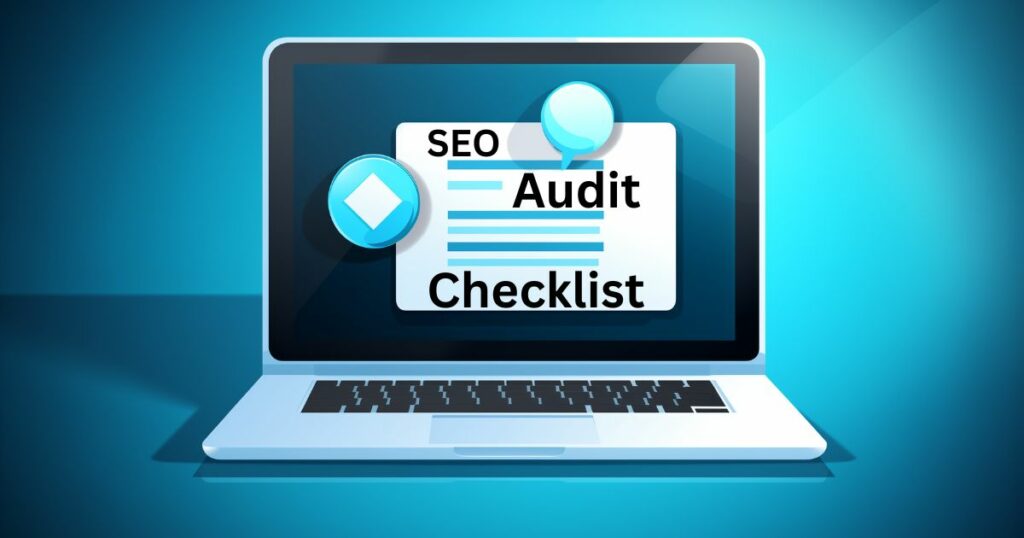When it comes to optimizing your website and improving its performance in search engine rankings, conducting a thorough SEO audit is vital. An SEO audit checklist provides a comprehensive guide, ensuring that no aspect of your website goes unnoticed.
From on-page and off-page optimization to keyword research, content optimization, technical SEO, and backlink analysis, this checklist covers all the essential steps to boost your online presence and surpass your competition in the digital landscape.
Key Takeaways:
- Performing an SEO audit is crucial for effective website optimization.
- An SEO audit checklist covers various aspects, including on-page and off-page optimization, keyword research, content optimization, technical SEO, and backlink analysis.
- Regularly conducting an SEO audit can help improve your website’s performance in search engine rankings.
- By following a checklist, you can identify and address any potential issues affecting your website’s visibility and organic traffic.
- Optimizing your website based on the SEO audit checklist can give you a competitive edge in the online market.
Step 1: Check To See If Your Site Is Mobile-Friendly
With the majority of Google searches now coming from mobile devices, it is crucial to ensure that your website is mobile-friendly. Google’s Mobile-First Algorithm means that the mobile version of your site is used for both mobile and desktop searches.
To check if your site is mobile-friendly, you can use Google’s Mobile-Friendly Testing Tool. This step is essential to ensure that your website is optimized for mobile devices and provides a seamless user experience across different platforms.
Having a mobile-friendly website is not only important for user experience but also for search engine optimization. Google considers mobile-friendliness as a ranking factor, which means that if your site is not mobile-friendly, it may not rank as well in search results.
In addition to the Mobile-Friendly Testing Tool, you can also use Google Search Console to identify any mobile usability issues on your site. This tool provides insights into specific mobile-related issues that may be affecting your website’s performance. By addressing these issues, you can improve your site’s mobile-friendliness and increase its visibility in mobile search results.
Ensuring that your website is mobile-friendly is a crucial step in optimizing your site for search engines and providing a seamless user experience. With the increasing use of mobile devices for online searches, it is more important than ever to prioritize mobile-friendliness in your website design and development.
By implementing responsive design and optimizing your site for mobile devices, you can attract more mobile users, reduce bounce rates, and improve conversion rates. Remember, a mobile-friendly website is not just a recommendation but a requirement for success in the digital age.
Step 2: Make Sure Google Indexes ONE Version of Your Website
When it comes to ensuring your website’s visibility on Google, it’s essential to make sure that the search engine indexes only one version of your site. Having multiple versions, such as HTTP and HTTPS, with or without www, can lead to indexing problems and inconsistent search results.
To avoid this, you need to implement a 301 redirect, which will redirect all versions of your site to the preferred version you want to use.
The 301 redirect is a server-side redirect that notifies both users and search engines that the page they are trying to access has permanently moved to a new location. By using the 301 redirect, you can consolidate the indexing power of different versions of your site into one, ensuring that Google only crawls and indexes the preferred version.
| Version | 301 Redirect |
|---|---|
| HTTP | Redirected to preferred version |
| HTTPS | Redirected to preferred version |
| With www | Redirected to preferred version |
| Without www | Redirected to preferred version |
Implementing the 301 redirect ensures that all search engine traffic and link equity will flow seamlessly to the correct version of your website. It also prevents duplicate content issues and helps Google understand the preferred version to include in its index.
By consolidating the indexing power and eliminating indexing problems caused by multiple versions of your website, you can create a consistent online presence and improve your website’s performance in search engine rankings.
Step 3: Speed Up Your Site
Page loading speed plays a critical role in your website’s performance and search engine rankings. Slow-loading websites can result in high bounce rates and poor user experience, which negatively impact your online visibility. To optimize your site’s loading speed, you should focus on a few key areas:
Clean Up Your HTML Code
Review your website’s HTML code and eliminate any unnecessary elements that may contribute to slower loading times. Bloated code and excessive scripts can hinder page performance. By streamlining your code, you can reduce the file size and improve loading speed. Use online tools to minify and clean up your HTML code effectively.
Identify Bottlenecks with Speed Tests
Running a speed test can help you identify the specific bottlenecks or issues that affect your site’s loading speed. These tests analyze various aspects of your website, such as server response time, file size, and resource loading order. They provide insights into areas that require optimization.
Some popular speed testing tools include:
- Google PageSpeed Insights
- GTMetrix
- Pingdom
Optimize Image Compression
Images are often a significant contributor to slow-loading websites. Optimizing image compression can significantly reduce file size without compromising quality. Compressed images load faster, improving your site’s overall performance.
Here are some tips for image optimization:
- Resize images to the appropriate dimensions for your website.
- Use image compression tools like Compressor.io or TinyPNG to reduce file sizes without loss of quality.
- Consider using modern image formats like WebP, which generally have smaller file sizes compared to JPEG or PNG.
Consider Upgrading Your Hosting Provider
Your web hosting provider plays a crucial role in determining your site’s loading speed. Shared hosting plans may limit server resources, resulting in slower performance during peak traffic. Consider upgrading to a dedicated or cloud hosting option to ensure faster loading times and improved user experience.
By implementing these optimization techniques, you can enhance your site’s loading speed, improve user experience, and boost your search engine rankings.
| Before Optimization | After Optimization | |
|---|---|---|
| Page Load Time | 5.2 seconds | 2.1 seconds |
| Page Size | 2.5MB | 1.2MB |
| Requests | 90 | 45 |
Step 4: Find and Delete “Zombie Pages”
Zombie Pages are low-quality or irrelevant pages on your website that are unnecessarily indexed by Google. These pages can negatively impact your website’s performance and hinder your organic traffic. To improve your website’s visibility and attract more organic traffic, it is essential to find and delete these Zombie Pages.
Common types of Zombie Pages include:
- Archive pages
- Category and tag pages
- Search result pages
- Old press releases
- Thin content pages
By removing these pages, you can provide Google with better quality content, ensuring that only valuable and relevant pages are indexed. This step is critical for streamlining your website’s architecture and making content optimization easier.
Deleting Zombie Pages can have a significant impact on your website’s overall performance. By eliminating low-quality content, you can:
- Improve your organic traffic
- Enhance user experience
- Boost your website’s authority
- Increase your chances of ranking higher in search results
To identify Zombie Pages, you can use tools like Google Analytics and Google Search Console. These tools provide valuable insights into pages with low traffic or high bounce rates, indicating that they may be Zombie Pages.
Once you have identified these pages, you can take the necessary steps to delete them or improve their quality. This may involve rewriting content, redirecting pages, or archiving outdated material.
Remember, quality over quantity is key when it comes to your website’s content. Removing Zombie Pages is an essential part of content optimization and can significantly improve your website’s performance in search engine rankings.
Eliminating Zombie Pages can breathe new life into your website, improving its visibility, attracting more organic traffic, and ensuring that your content is valuable and relevant to your audience.
| Zombie Page Type | Impact on Website Performance |
|---|---|
| Archive pages | Clutters website structure, dilutes SEO efforts |
| Category and tag pages | Creates duplicate content issues, lowers ranking potential |
| Search result pages | Generates thin and low-quality content, reduces user experience |
| Old press releases | Irrelevant and outdated information, decreases website authority |
| Thin content pages | Offers little value to users, may lead to penalties from search engines |
Deleting Zombie Pages not only improves your website’s performance but also ensures that your content remains valuable, relevant, and optimized for search engines. Take the necessary steps today to eliminate these pages and optimize your website for better organic traffic and search engine visibility.
Step 5: Find and Fix Indexing Problems
One of the key aspects of optimizing your website for better search engine visibility is ensuring that all your web pages are correctly indexed by Google.
While Google’s algorithm strives to crawl and index as many pages as possible, there can be instances where certain pages may not get indexed due to various reasons. In this step, I will guide you on how to identify and fix any indexing problems using tools like Google Search Console and Screaming Frog.
Using Google Search Console
Google Search Console is a powerful tool that provides valuable insights into how Google crawls and indexes your website. One of the most useful features of Google Search Console is the “Index Coverage” report, which highlights any pages on your site that Google cannot index. By regularly monitoring this report, you can quickly identify any indexing issues that need attention.
To access the “Index Coverage” report in Google Search Console, follow these steps:
- Login to your Google Search Console account
- Select your website property
- In the left-hand menu, click on “Index” and then “Coverage”
The “Index Coverage” report will provide you with a list of URLs that have indexing issues, such as pages that are blocked by robots.txt, have a “noindex” tag, or are affected by other crawl errors. By reviewing and addressing these issues, you can ensure that all the pages you want Google to index are accessible and appear in search results.
Using Screaming Frog
In addition to Google Search Console, another useful tool for identifying indexing problems is Screaming Frog. This website crawler allows you to quickly analyze your website and detect any accessibility issues that may hinder indexing.
Here’s how you can use Screaming Frog to find indexing problems:
- Download and install Screaming Frog
- Launch the software and enter your website URL
- Allow the crawler to analyze your website
- Once the analysis is complete, navigate to the “Response Codes” tab
- Look for pages that have a “Blocked by robots.txt” or “Noindex” status
Screaming Frog will provide a comprehensive list of pages that have accessibility issues, helping you identify which pages are not being indexed by Google. By fixing these problems, you can ensure that all your valuable content is visible to search engines and can contribute to your website’s visibility in search results.
Maximizing the visibility of your website in search engines is crucial for driving organic traffic and attracting potential customers. By using tools like Google Search Console and Screaming Frog to identify and fix indexing problems, you can ensure that your web pages are accessible to search engines and increase your chances of appearing in relevant search results.
Stay tuned for the next step, where I will guide you on how to check your organic traffic and analyze the effectiveness of your SEO efforts.
Step 6: Check Your Organic Traffic
Analyzing your website’s organic traffic is a crucial step in evaluating the effectiveness of your SEO efforts. By monitoring the number of visitors coming to your site from search engines, you can gain valuable insights into the impact of your optimization strategies.
Google Analytics provides a comprehensive set of tools to track, measure, and analyze your website’s performance, including organic search traffic.
With Google Analytics, you can:
- Track the number of organic visitors to your site
- Monitor the performance of specific landing pages
- Identify which search terms are driving traffic to your site
- Measure the bounce rate and average session duration of organic visitors
- Explore audience demographics and interests
By comparing your organic traffic over a specific period, such as monthly or quarterly, you can assess the effectiveness of your SEO strategies.
Positive trends in organic traffic indicate that your optimization efforts are paying off, while stagnation or decline may suggest the need for adjustments or additional tactics. Setting benchmarks and tracking your progress over time can help evaluate the success of your SEO campaign.
Regularly monitoring your organic traffic allows you to identify areas that need improvement. By understanding which pages are performing well and which ones are underperforming, you can optimize your content, improve user experience, and target keywords more effectively.
Additionally, analyzing audience behavior can provide insights into user preferences and inform your content strategy.
“Analyzing organic traffic helps you gauge the effectiveness of your SEO campaign and make data-driven decisions for improvement.” – Me
Conclusion
Conducting an SEO audit using the checklist outlined in this article can be a game-changer for your website optimization efforts.
By optimizing various aspects of your site, from ensuring mobile-friendliness to improving content quality and conducting backlink analysis, you can significantly improve your rankings in search engine results and increase your online visibility.
It is crucial to regularly monitor your analytics and make necessary adjustments to ensure the continued success of your SEO strategy. By analyzing data and identifying areas for improvement, you can stay ahead of the competition and maintain a strong online presence.
With this comprehensive SEO audit checklist, you will be well-equipped to enhance your website’s performance and outperform your competition. Remember that website optimization is an ongoing process, and by following this checklist, you can continuously fine-tune your site and maximize its potential in the ever-evolving digital landscape.
FAQ
What is an SEO audit checklist?
An SEO audit checklist is a comprehensive guide that outlines the essential steps to optimize your website and improve its performance in search engine rankings.
It covers various aspects of SEO analysis, including on-page optimization, off-page optimization, keyword research, content optimization, technical SEO, website performance, and backlink analysis.
How can I check if my site is mobile-friendly?
To check if your site is mobile-friendly, you can use Google’s Mobile-Friendly Testing Tool. With the majority of Google searches coming from mobile devices, it is crucial to ensure that your website is optimized for mobile devices and provides a seamless user experience across different platforms.
Why do I need to redirect all versions of my website to one preferred version?
It is possible to have different versions of your website indexed in Google, such as HTTP and HTTPS, with or without www. To avoid Google considering these versions as separate websites, you need to ensure that they are properly redirected to one preferred version using a 301 redirect.
This step is important to maintain consistency and prevent any indexing problems caused by multiple versions of your website.
How can I improve my site’s loading speed?
To improve your site’s loading speed, you can start by cleaning up your site’s HTML code and eliminating any unnecessary elements that may slow down the loading time. Running a speed test can help identify bottlenecks and issues that affect your site’s performance.
Additionally, optimizing images by compressing their size can significantly improve loading speed. Upgrading your hosting provider can also contribute to faster loading times.
What are Zombie Pages and why should I delete them?
Zombie Pages refer to low-quality or irrelevant pages on your website that are unnecessarily indexed by Google. Deleting these Zombie Pages can help improve your organic traffic and boost your website’s overall performance. By removing these pages, you can provide Google with better quality content and improve your website’s visibility in search results.
How can I find and fix indexing problems on my website?
Using Google Search Console, you can identify web pages that Google can’t index for various reasons. The “Index Coverage” report in Google Search Console provides insights into pages that need attention.
Additionally, tools like Screaming Frog can help identify pages that have accessibility issues, such as pages blocked by robots.txt or pages with a noindex tag. Fixing these indexing problems ensures that all the pages you want Google to index are accessible and can appear in search results.
How can I check my website’s organic traffic?
Analyzing your website’s organic traffic is an important step in evaluating the effectiveness of your SEO efforts. Using Google Analytics, you can track the number of visitors coming to your site from search engines.
By comparing your organic traffic over a specific period, you can determine whether your SEO strategies are driving results. Monitoring your organic traffic regularly can help you measure the success of your SEO campaign.
How can an SEO audit checklist help my website optimization efforts?
Conducting an SEO audit using the checklist outlined in this article can be a game-changer for your website optimization efforts. By optimizing various aspects of your site, from mobile-friendliness to content quality and backlink analysis, you can improve your rankings in search engine results and increase your online visibility.
Regularly monitoring your analytics and making necessary adjustments will ensure the continued success of your SEO strategy.



